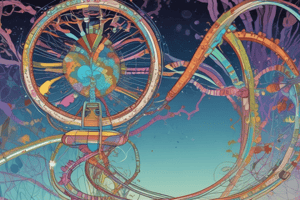Podcast
Questions and Answers
Which condition is characterized by myopathy, lactic acidosis, and stroke-like episodes?
Which condition is characterized by myopathy, lactic acidosis, and stroke-like episodes?
- Leigh Syndrome
- MELAS (correct)
- Kearns-Sayre syndrome
- MERF
What type of mutations are commonly associated with Pearson Syndrome?
What type of mutations are commonly associated with Pearson Syndrome?
- Large deletions (correct)
- Heteroplasmic mutations in ATPase
- Homoplasmic mutations in rRNA
- Point mutations in tRNA
Which disorder is linked to mutations in the 12S rRNA gene?
Which disorder is linked to mutations in the 12S rRNA gene?
- Leigh Syndrome
- MELAS
- Deafness (correct)
- Kearns-Sayre syndrome
What inheritance pattern is most likely associated with the majority of mitochondrial disorders?
What inheritance pattern is most likely associated with the majority of mitochondrial disorders?
Which of the following is a common congenital malformation associated with multifactorial inheritance?
Which of the following is a common congenital malformation associated with multifactorial inheritance?
What is a consequence of reduced penetrance in genetic inheritance?
What is a consequence of reduced penetrance in genetic inheritance?
Which of the following best describes 'variable expressivity'?
Which of the following best describes 'variable expressivity'?
What is a unique characteristic of mitochondrial disorders?
What is a unique characteristic of mitochondrial disorders?
In what way does uniparental disomy affect genetic inheritance?
In what way does uniparental disomy affect genetic inheritance?
Which of the following describes the concept of 'anticipation' in genetic disorders?
Which of the following describes the concept of 'anticipation' in genetic disorders?
What distinguishes co-dominancy from traditional dominant and recessive inheritance?
What distinguishes co-dominancy from traditional dominant and recessive inheritance?
How can mosaicism affect the expression of genetic disorders?
How can mosaicism affect the expression of genetic disorders?
Which statement about genomic imprinting is true?
Which statement about genomic imprinting is true?
What is the significance of homoplasmy and heteroplasmy in mitochondrial genetics?
What is the significance of homoplasmy and heteroplasmy in mitochondrial genetics?
Flashcards
Non-Mendelian Inheritance
Non-Mendelian Inheritance
Inheritance patterns that do not follow Mendel's laws, including exceptions to Mendelian inheritance and other mechanisms like epigenetics, imprinted genes, and mitochondrial inheritance.
Reduced Penetrance
Reduced Penetrance
A genotype may not always produce the expected phenotype.
Variable Expressivity
Variable Expressivity
The severity or presentation of a genetic trait can vary among individuals with the same gene.
Codominance
Codominance
Signup and view all the flashcards
Skewed X inactivation
Skewed X inactivation
Signup and view all the flashcards
Epigenetics
Epigenetics
Signup and view all the flashcards
Genomic Imprinting
Genomic Imprinting
Signup and view all the flashcards
Imprinting Disorders
Imprinting Disorders
Signup and view all the flashcards
Uniparental Disomy (UPD)
Uniparental Disomy (UPD)
Signup and view all the flashcards
Triple Repeat Disorders
Triple Repeat Disorders
Signup and view all the flashcards
Mosaicism
Mosaicism
Signup and view all the flashcards
Mitochondrial Disorders
Mitochondrial Disorders
Signup and view all the flashcards
Multifactorial Inheritance
Multifactorial Inheritance
Signup and view all the flashcards
Homoplasmy
Homoplasmy
Signup and view all the flashcards
Heteroplasmy
Heteroplasmy
Signup and view all the flashcards
Replicative Segregation
Replicative Segregation
Signup and view all the flashcards
Mitochondrial Disorders
Mitochondrial Disorders
Signup and view all the flashcards
ATPase subunit 6 gene mutations
ATPase subunit 6 gene mutations
Signup and view all the flashcards
Leigh Syndrome
Leigh Syndrome
Signup and view all the flashcards
MELAS
MELAS
Signup and view all the flashcards
MERF
MERF
Signup and view all the flashcards
Deafness (Progressive Sensorineural)
Deafness (Progressive Sensorineural)
Signup and view all the flashcards
Pearson Syndrome
Pearson Syndrome
Signup and view all the flashcards
Kearns-Sayre Syndrome
Kearns-Sayre Syndrome
Signup and view all the flashcards
Multifactorial Inheritance
Multifactorial Inheritance
Signup and view all the flashcards
Multifactorial Diseases
Multifactorial Diseases
Signup and view all the flashcards
Study Notes
Non-Mendelian Inheritance
-
Exceptions to Mendelian Inheritance:
- Epigenetics
- Genomic Imprinting and Imprinting Disorders
- Uniparental Dysomy
- Triple Repeat Disorders
- Mosaicism
- Mitochondrial Disorders
- Multifactorial Inheritance
-
Reduced Penetrance:
- Phenotypically normal family members may not transmit the phenotype to their children
- Exceptions to typical Mendelian Inheritance patterns
- Variable expressivity
- Incomplete penetrance (graphics showing individuals with same genotype but different phenotypes)
-
Variable Expressivity:
- Individuals with the same genotype may have different phenotypes
- Shows a wide range of severity among affected individuals
- Illustrated with specific conditions (e.g., neurofibromatosis)
-
Co-dominance:
- Blood type inheritance: A, B, AB, O are codominant alleles
- Both alleles are expressed
-
Skewed X Inactivation:
- In X-linked recessive disorders, affected females can occur
- Due to an uneven inactivation of the X chromosome
-
Genomic Imprinting:
- Genes expressed differentially based on parental origin
- Impacts traits like Prader-Willi syndrome and Angelman syndrome
- Both disorders are linked to the same region on chromosome 15
-
Uniparental Disomy:
- Offspring inherit two copies of a chromosome from one parent
- Can lead to disorders
-
Triple Repeat Disorders:
- Associated with expansions in specific triplet repeats in genes
- Examples include Fragile X syndrome, Huntington's disease, and myotonic dystrophy
- Genetic anticipation( earlier onset and increased severity) is a key aspect of these disorders
-
Mosaicism:
- Presence of different cell lines within an individual due to cell division errors
- Can affect single-gene disorders
- Types: Somatic, germline, and combined mosaicism
-
Mitochondrial Disorders:
- Inherited maternally
- Caused by mutations in mitochondrial DNA(mtDNA)
- Different mtDNA levels and variants cause different tissue and phenotypic manifestations
-
Multifactorial Inheritance:
- Caused by a combination of genetic and environmental factors
- Examples include congenital heart defects, neural tube defects, pyloric stenosis, and common diseases
- Environmental factors affect phenotype based on genetic predisposition
- Single nucleotide polymorphism(SNP) are a type of genetic variant that is common within the population
Studying That Suits You
Use AI to generate personalized quizzes and flashcards to suit your learning preferences.




